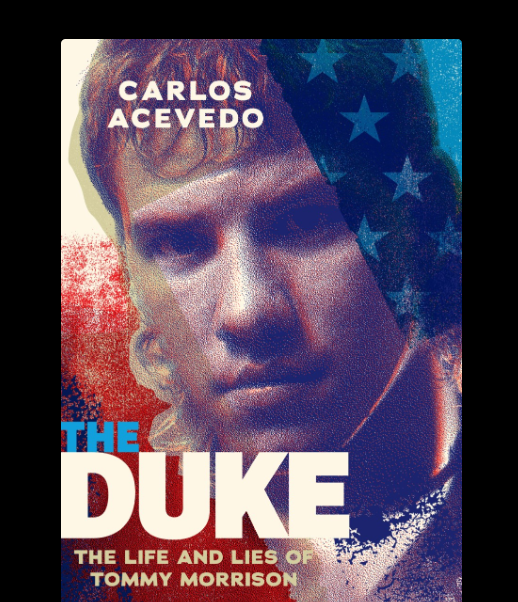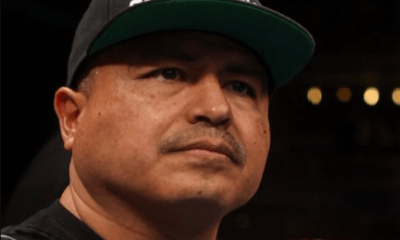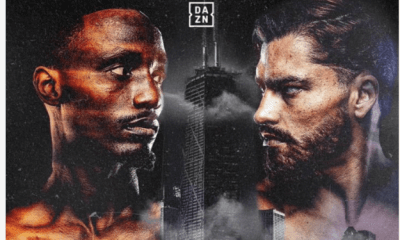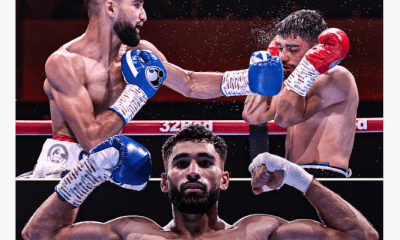Book Review
Book Review — “The Duke: The Life and Lies of Tommy Morrison”

Tommy Morrison was born in Gravette, Arkansas, on January 2, 1969, and lived in Oklahoma for most of his life. He fought in countless toughman contests, had three organized amateur bouts, and turned pro in 1988. Over the next seven years, he compiled a 45-3-1 (39 KOs, 3 KOs by) ring record, the high point of which was a 118-109, 117-110, 117-110 decision over George Foreman in 1993 to claim the vacant WBO heavyweight throne.
In Foreman’s next fight, he knocked out Michael Moorer to annex the WBA, IBF, and lineal heavyweight titles. In Morrison’s next fight, he was knocked out by Michael Bentt in the first round.
Morrison’s other losses were brutal “KOs by” at the hands of Ray Mercer and Lennox Lewis. During the course of his career, he knocked out faded versions of James Tillis, Pinklon Thomas, Joe Hipp, Carl Williams, and Razor Ruddock. As a postscript, between 1996 and 2008, he scored stoppages over three particularly inept opponents after having been diagnosed as HIV-positive. He died in 2013 at age 44.
The Duke: The Life and Lies of Tommy Morrison by Carlos Acevedo (Hamilcar Publications) chronicles Morrison’s life.
“Morrison,” Acevedo writes, “came from a broken home. He was a secondhand son, passed from here to there, from nowhere to nowhere bound, wherever he would stick. His father was abusive. His mother once beat a murder charge. His brother would spend fifteen years in prison for rape. And Tommy? His mother first made him use his fists when he was five years old.”
“I was the guy your parents warned you about in high school,” Morrison cautioned.
The Duke is divided into two parts. Part I deals with Morrison as a fighter. His early ring record was fashioned against a collection of hopeless opponents. Then Bill Cayton took over as lead manager and Tommy graduated to a higher grade of stiff. Cayton built Morrison brilliantly as an attraction. He propagated the deceit that Tommy was a distant relative of movie star John Wayne and was instrumental in landing Morrison the role of Tommy Gunn in Rocky V. Cayton also used his skill and economic power to ensure that Morrison was featured on high-profile boxing telecasts.
At times, Morrison struggled in the ring. “He was,” Acevedo writes, “especially susceptible to right hands. And when he opened fire, he often did so squared-up to his opponent which made him a big target and left him exposed to counterpunches.” Moreover, Morrison trained less rigorously than he should have and burned the candle at both ends. “Let’s put it this way,” Cayton said. “Tommy Morrison makes Mike Tyson look like a monk.”
But as Acevedo notes, “Morrison worked the body with zeal, often doubling up hooks with either hand after landing to the rib cage. His signature right-to-the-body-right-uppercut combination was both lethal and often unexpected. In close, Morrison could surprise an opponent from either side with damaging shots. There was also the undeniable potency of his left hook. And Morrison showed the kind of heart often lacking among his peers. Morrison was someone who had to be nailed to the canvas before he lost.”
It was inevitable that Morrison would come to be spoken of as a “Great White Hope.” To his credit, he did his best to avoid making race an issue. “It’s kind of sad,” he told the Kansas City Star. “To be honest, it’s a big advantage being white. There aren’t that many white fighters around. But I’d prefer to stay away from that because it’s racist.”
By 1991, Morrison had run his record to 28-0 with 24 knockouts. Then Cayton matched him against Ray Mercer for the WBO heavyweight title. It was a mistake. For three rounds, Morrison dominated the action, pounding the granite-chinned Mercer with sledgehammer blows. Then Tommy ran out of gas and, in round five, was knocked unconscious.
Undeterred, Cayton rebuilt Morrison’s credibility, matching him in fights that resulted in seven wins and a draw over the next seventeen months. That led to a two-million-dollar payday against George Foreman in a 1993 bout for the WBO heavyweight title that Mercer had vacated after beating Morrison. Fighting against Foreman with uncharacteristic caution and in excellent condition for one of the few times in his career, Tommy emerged victorious.
The world was now Morrison’s oyster. He had a belt and was a big name in the heavyweight division. A deal was made for a title unification bout against Lennox Lewis that would pay Tommy a minimum purse of $7.5 million. But first, Morrison wanted an interim fight against a walkover opponent in Oklahoma. The walkover opponent was Michael Bentt.
KO by 1.
“All fighters reach a peak,” Acevedo writes. “A point at which the rigors of training and the punishment received in the ring combine to break them down. For some fighters, particularly aggressive ones such as Morrison, short peaks are the rule. [After the Bentt fight], it was clear that Morrison was beyond his best days. Over the span of two years, from October 1993 to October 1995, he was knocked down ten times. And Morrison compounded these issues with a torrid nightlife, a lax attitude toward training, and a dependency on steroids that likely had an adverse physical effect on him.”
Ah, yes. Morrison’s night life.
Part II of The Duke deals with Tommy’s life outside the ring. In his later years, he would use cocaine, crystal meth, Adderall, and Special K. In the early-1990s, he was a drinker. And alcohol fueled his temper.
“Morrison,” Acevedo writes, “was the kind of drunk who would pick fights in public and reject outright the concept of a designated driver. He could also become violent when under the influence.”
A drunk Morrison slashed an exotic dancer with a broken beer bottle in Kansas City. She sued. According to John Brown (Morrison’s co-manager), the case was settled for $100,000.
Morrison pled guilty to simple assault and public intoxication in conjunction with another incident and was fined $310. He was also arrested and pled no contest to two misdemeanor counts of assault and battery stemming from an altercation at a party given by Tammy Witt (the mother of his son, Trey). In that instance, Morrison received a suspended sentence, was fined $600, and ordered to perform thirty hours of community service.
But the drinking was nothing compared to the women.
“In the wake of Rocky V,” Acevedo recounts, “Morrison had become what John Brown called a ‘Bimbo Magnet.’ At the peak of his stardom, between the premiere of Rocky V and his upset loss to Michael Bentt, he lived out an adolescent fantasy that might have been the rudimentary plot of a teen sexploitation film. His life was truly a wild one. Wherever Morrison went, he trailed yearning women behind him. They shadowed him at personal appearances, before fights, after fights, in lobbies, restaurants, bars, and clubs. Few celebrities, even minor ones, spend their nights partying in Kansas City or Jay [Oklahoma] or Iowa. But Morrison had little interest in the bright lights of New York City or Los Angeles. The local whirlwind he created in small towns was more than enough for him.”
“His attraction to women was more than anything you can imagine,” Bill Cayton told a reporter for the Vancouver Sun. “He was a womanizer beyond anything I’ve ever known.”
“It was unbelievable,” Morrison said to Sports Illustrated. “It was all right there. You could feed yourself as fast and as much as you wanted.”
Then everything changed. For the worse.
Much worse.
On February 10, 1996, Nevada State Athletic Commission executive director Marc Ratner announced that, for medical reasons, Morrison had been scratched from a fight card scheduled for the MGM Grand Hotel & Casino that night. Ratner declined to specify what the medical issue was. Five days later, at a press conference held at the Southern Hills Marriot Hotel in Tulsa, Oklahoma, Morrison addressed the issue with candor and grace.
“First of all, I’d like to thank everybody for being here today,” Morrison said. “I’m sorry that I couldn’t be here in person on Monday when Tony [promoter Tony Holden] informed you of what the present situation was. At that time, I felt it was more important to be with my family. Since that time, I’ve taken action to have more extensive tests run. I was informed just a little while ago that those tests do in fact confirm that I have tested positive for the HIV virus. There was a certain point and time in my life that I lived a very permissive, fast, reckless lifestyle. I knew that the HIV virus is something that anyone could get, but I also believed the chances were very, very slim. I thought that the real danger of contracting this rests in the arms of those who subject themselves to certain types of lifestyles – addicts who share needles, people who practice a homosexual lifestyle. I honestly believed that I had a better chance of winning the lottery than contracting this disease. I have never been so wrong in my life. To all my young fans out there, I’d ask that you no longer see me as a role model but see me as an individual who had an opportunity to be a role model and blew it. Blew it with irresponsible, irrational, immature decisions; decisions that one day could cost me my life.”
That was laudable. But within seven months, Morrison had pivoted 180 degrees. He had come to believe that HIV was a hoax and that the drugs developed to fight it were, in fact, designed to kill patients. In Acevedo’s words, “like so many other fanatics, [Morrison] ignored facts and substituted intuition for verifiable science.”
Now Morrison had a different view of his own medical condition. “I don’t have a lot of confidence in all this medication,” he said. “I’ve chosen not to take it. See, I don’t think that HIV causes AIDS. Some of the research I’ve read and some of the doctors I’ve talked to – there are still a lot of unanswered questions. It hasn’t been proven scientifically to my satisfaction that HIV leads to AIDS. It’s the medication that’s killing people. You unravel the little piece of paper in the bottle and you read about the side effects and they match identical with the symptoms of AIDS. HIV’s never been proven to cause AIDS. HIV ain’t never killed anybody.”
Thereafter, Morrison repeatedly denied that he was HIV-positive. But as Acevedo notes, “A lawsuit [instituted after Morrison’s death] brought to light dozens of documents revealing medical records that repeat over and over the fact that Tommy Morrison had HIV. These records include prescriptions, credit card statements, test results, memos from physicians, expert testimony, even psychiatric intake notes. The evidence that Morrison had been living with HIV for years is overwhelming.”
The end game for Morrison was long and ugly, marked by alcoholism, drug abuse, and uncontrolled aggression. But as Acevedo states, “Nothing about his carnal lifestyle – reckless, aimless, remorseless, seemingly bottomless – is as shocking as the willingness of dozens of women to risk a potential death sentence by sleeping with the most famous carrier of HIV outside of Magic Johnson.”
In Acevedo’s eyes, Morrison was now a menace to society.
He was also a bigamist, having married two different women (Dawn Freeman and Dawn Gilbert) in 1996. He would marry for a third time in 2011, two years before he died.
Meanwhile, again and again, Morrison was getting arrested. Twice in 1997 on charges ranging from driving under the influence to carrying a loaded firearm while under the influence of intoxicants, On December 20, 1997, he was sentenced to six months in prison (later reduced to thirty days). The following year, he was arrested again; this time for driving under the influence, destruction of private property, running a red light, and driving with a revoked license. In 2000, he pled guilty to myriad charges and was sentenced to ten years in prison with eight years suspended. He was released after fourteen months.
Morrison also subjected himself to cosmetic surgery that amounted to self-mutilation. As recounted by Acevedo, “In June 1999, Morrison underwent a series of surgeries for chest and biceps implants in Tulsa with nightmarish results. When the last procedure was over, Morrison and Landon [a friend] checked into a motel for a brief recovery period. That was where Dawn Gilbert found Morrison, looking like the creation of a Hollywood-style mad scientist.”
Landon told Gilbert that the doctor had used implants for the biceps rebuild that appeared to be shin guards bought from a sporting goods store. “As disturbing as his new implants were,” Acevedo notes, “the most shocking part of his appearance was the multiple tubes that now protruded from his body, each attached to one of the four bags surrounding him. Tubes came from each armpit and each bicep, and the bags contained a yellowish gunk and blood.”
Yet bizarrely, Morrison continued to fight. On November 3, 1996 (less than nine month after first testing HIV-positive), he’d been allowed to enter the ring in Tokyo and scored a first-round knockout over Marcus Rhode. Then, after a decade-long absence, he returned to boxing and stopped two no-hope opponents in West Virginia (2007) and Mexico (2008).
And all the while, his mind was rotting away.
“When he was only in his mid-thirties,” Acevedo writes, “Morrison was already exhibiting classic signs of pugilistic dementia. Slurred speech, forgetfulness, scattered thoughts, a scanty attention span. He increasingly suffered from paranoia. His IQ was measured at 78, which placed Morrison on the borderline for mental disability. Anyone who had heard Morrison speak after fights or read his interviews knew that he was an eloquent young man capable of expressing himself in complex sentences. By the time he hit rock bottom, that was no longer the case.”
Morrison, Acevedo continues, “also suffered from the burnout effect of methamphetamines. And in the early 2000s, he was diagnosed with HIV-related encephalopathy. Combined with his career as a prizefighter, these afflictions left him with a tenuous grip on reality. ESPN interviewed Morrison in 2000 while he was serving out a term in a Texarkana lockup for a variety of drug-related charges. In his orange prison garb, Morrison looked like he had just returned from a week-long crank binge in Arkansas swampland. He was heavy-lidded; some of his teeth were missing; he spoke haltingly; many of his answers were rote; his hair had thinned into a wispy comb-over. And he seemed delusional.”
Fast-forward to 2011. Morrison was arrested twice more on charges that included felony possession of controlled substances and misdemeanor possession of paraphernalia for use. Acevedo recreates what followed:
“The sports world is shocked to see the latest mug shot of Tommy Morrison, an image that seems to foreshadow death. Only forty-two years old, Morrison resembles a vagrant who has just returned from a harrowing ordeal. A video of his court appearance is even more disturbing. Morrison looks like a cross between a confused little boy and a senile old man. He is haggard, ashen, bewildered.”
At that point, the criminal justice system applied what Acevedo calls “pragmatic mercy.”
“Simply put,” he writes, “Morrison is unfit for prison. He is, by then, unfit for anything. In less than two years, he will be dead.”
In evaluating The Duke, one should begin with a thought from Acevedo himself who cautions, “Any biographical narrative is bound to raise questions of veracity. The life of Tommy Morrison more so, perhaps, because of how much of it took place in half-light. Toughman contests, club fights in Wichita and Great Falls, orgies in rattletrap motels, stints in jail and prison, and night crawling with tweakers from crash pad to crash pad across the Southeast. By nature, Morrison seemed drawn to subterranean pursuits.”
That said, Acevedo writes well. His tale moves briskly through Morrison’s life from his hardscrabble origins to his self-destructive end. The recounting of Morrison’s ring career doesn’t have the depth and nuance of some of Acevedo’s earlier writing about boxing. And there are times when he gives Morrison less credit than Tommy might deserve as a fighter.
But The Duke comes to life in Part Two. The material dealing with Morrison’s spiral into oblivion outside the ring is powerfully written and informative. Acevedo shows here that he’s a very good writer.
Thomas Hauser’s email address is thomashauserwriter@gmail.com. His most recent book – Broken Dreams: Another Year Inside Boxing – was published by the University of Arkansas Press. In 2004, the Boxing Writers Association of America honored Hauser with the Nat Fleischer Award for career excellence in boxing journalism. In 2019, Hauser was selected for boxing’s highest honor – induction into the International Boxing Hall of Fame.
To comment on this story in the Fight Forum CLICK HERE
-

 Featured Articles4 weeks ago
Featured Articles4 weeks agoResults and Recaps from New York Where Taylor Edged Serrano Once Again
-

 Featured Articles1 week ago
Featured Articles1 week agoThe Hauser Report: Zayas-Garcia, Pacquiao, Usyk, and the NYSAC
-

 Featured Articles3 days ago
Featured Articles3 days agoOscar Duarte and Regis Prograis Prevail on an Action-Packed Fight Card in Chicago
-

 Featured Articles3 weeks ago
Featured Articles3 weeks agoResults and Recaps from NYC where Hamzah Sheeraz was Spectacular
-

 Featured Articles4 weeks ago
Featured Articles4 weeks agoFrom a Sympathetic Figure to a Pariah: The Travails of Julio Cesar Chavez Jr
-

 Featured Articles2 weeks ago
Featured Articles2 weeks agoManny Pacquiao and Mario Barrios Fight to a Draw; Fundora stops Tim Tszyu
-

 Featured Articles4 weeks ago
Featured Articles4 weeks agoPhiladelphia Welterweight Gil Turner, a Phenom, Now Rests in an Unmarked Grave
-

 Featured Articles2 weeks ago
Featured Articles2 weeks agoArne’s Almanac: Pacquiao-Barrios Redux





















